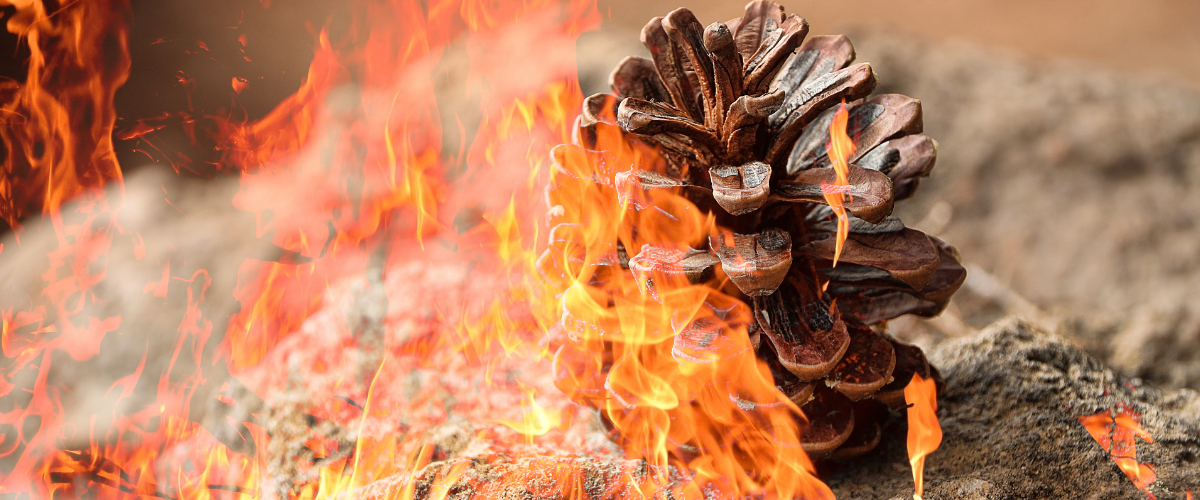Before you can have a campfire, you need to start the fire. Sounds obvious, but the practice of fire starting is almost an art in and of itself. But there are a few simple tricks you can use to ensure you get a fire going consistently.
Before I start listing off some effective and easy fire starters, I want to provide some generalize wisdom that will also make a big difference:
- Keep everything dry. It doesn’t matter how good of a fire starter you have, if the wood you want to burn is wet, there’s not much you can do. This also means that on particularly humid days, it’ll be harder for a fire to start and stay alive. You can’t prevent a humid day, but doing things like covering your firewood with tarps and picking branches from dry locations will help a lot.
- Consider the wind. Too much wind can snuff out a fire while it’s small. Too little wind, and you’ll need to coax the flames to burn hotter. If you’re having windy trouble, try covering or encasing the fire starters in a small pocket where wind can’t easily access. If there’s no wind, be sure to coax it (not too strongly) with a fan.
- It needs to get hot. Fire is heat, but it also needs heat. If the starts are igniting, but it doesn’t seem to be taking off, you might need more heat. Try covering the fire starts a little with things like dry bark, cardboard, or other burning material. By placing over the starts, it will help keep the heat from immediately floating away.
With that out of the way, here are some easy, DIY style homemade fire starters. I know you can purchase mass-produced fire starters. And they’re pretty cheap too. But where’s the fun in that. Here are some DIY options.
Cotton Balls and Vaseline
This is one of the most common improvised fire starters. They light really easily and stay going long enough to get the fire going. Simply work some Vaseline into a cotton ball. And since both items aren’t uncommon for first aid kits, they’re pretty accessible.
Personally, this isn’t high on my list. There are more accessible options that work just as well and doesn’t dip into your medical supplies. But it works, and deserves to be mentioned as such.
Sawdust in Wax
This is a trick my mother taught me. She would take a cardboard egg carton, fill them with sawdust and wood shavings from the workshop, and pour in wax from her candles. The wood engages the fire, while the wax keeps it from burning out too quickly. It also smelled really nice.
The main drawback here is needing to find a “container” to pour the material in. Not too many places have cardboard egg cartons anymore. Even then, it doesn’t ignite super well. Once it gets going, it runs a good long while, but getting there might be a challenge in poor conditions.
Dryer Lint in Cardboard
This is something my wife showed me, a trick she learned from Girl Scouts. She took some dryer link, rolled it up inside of cardboard (a toilet paper roll would also work amazingly) and tie it together with a bit of twine. When placed virtually and lit from below, they allowed the lint to ignite easily and stay protected from the wind. This is my favorite homemade fire starter.
Main downside is that you have to position them correctly to get the most out of them. They need to have the openings exposed upward, allowing the heat to rise into the kindling. Otherwise, it just burns slow and contained.
Tea Candles
Technically not a DIY recipe, it’s just a tea candle. Small and otherwise disposable, a tea candle will hold a small flame entirely on its own for a good long, time. It will provide plenty of time and heat to start up a fire, and some after that. Since you can get bulk candles, they’re very easy to have enough of. Plus, they double as portable light sources if needed.
The main downsides are that they don’t inherently ignite with ease. This is no problem if you have a match or lighter, but spark sticks might not suffice. Besides, if you’re buying things for fires, you might as well just buy the fire starters.
Pine Cones
This is a trick I learned from a Japanese camping show. If you have nothing to help start a fire, you can forage for pine cones. Fully opened cones that have dried out will work the best. Just gather an armful and place them at the base of the fire. They burn nicely and the high surface area means they’ll create a good starting flame.
Meant as an improvised option for times when you have nothing left. This isn’t optimal, but it will work.
Try to Not Use Gas/Fuel
You probably have seen or heard about people using lighter fluid or gasoline to help start a fire. I cannot suggest this. While it does help ignite a flame, you’ll still need a proper fire starter or kindling to catch and keep the flame. This method invites some major risks. Careless fuel placement or usage can lead to explosion, out of control fires, and injuries. It may sound tempting and easy, but please, don’t.

